
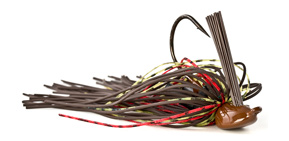
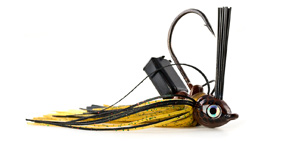
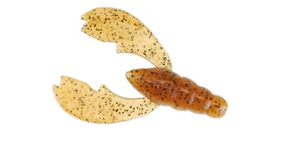
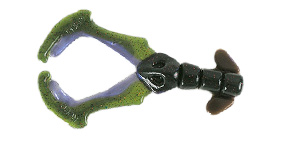
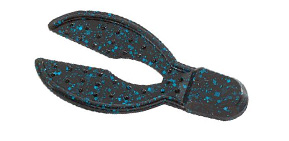
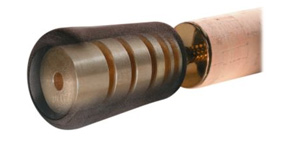

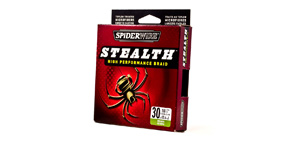
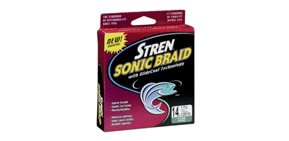

Selecting the Right Jig for Bass Fishing
Becoming a great jig fisherman starts at the tackle shop. In this video, we discuss the most important features of a jig and some valuable tips on how to modify your jigs to achieve greater success. Covering all the important jig fishing topics from color selection, using the correct jig trailers, new and innovative jigs on the market, selecting the right type and size fishing line and much more.

Before we can go forward, our discussion must begin with a breakdown of the different types of jigs available, and some quick observations about each. There are really 3 main types of jigs you can buy, and each has a specific purpose and place in bass fishing.
The first category of jigs are football jigs. These jigs are known for their blunt and wide football-shaped jigheads. They're heavier than most other jigs, typically between 1/2 oz and 1oz, with 3/4oz being very popular. Now the reason the jigheads are shaped like footballs is because you can crawl them over bare and gravel bottoms easily and they help anglers feel the bottom better. They've also been shown to not hang up as much in small rocks because of the wide and blunt head shape. A great jig design for water deeper than 10 feet and when you want to cover water on structure like points and ledges.
Now another jig design is what's called a grass jig. And the notable difference is the jighead shape. It's more pointed and narrow, allowing the jig to come through vegetation and weeds easily without getting covered in grass. That's really the only purpose and benefit of the grass jig, it's pointed head doesn't snag vegetation as easily.
The last major category of jigs is basically the "standard" or often termed, flipping jig. It's essentially an in-between, not too narrow, not to blunt design that's versatile in many different kinds of cover. Its real strengths are visible when fishing wood cover, be it laydowns, docks, and so on. It's best suited for heavy cover, and is certainly the most used of the three categories of jigs.
But let me just say that just because the flipping jig can be seen as the most "versatile", that doesn't mean that it can or should be used in all circumstances. That's why football jigs and grass jigs were invented.
So for this video, we are only going to be focusing on the standard flipping jig. While many discussions and topics, be it color selection or weed guards, share similarities, the goal of this video is to get as specific as possible in the shortest amount of time. So any talk about football jigs and grass jigs will be left to another video... and you'll see that in the future.
You know, one of the big changes we're witnessing right now in the jig industry is the availability of tungsten jigs. In years past, jigs were always poured with lead jigheads because of its low-cost and easy manufacturing. While most jigs on the market today are still leadhead jigs, a few companies have already introduced a tungsten line. Companies like Tru-Tungsten, Keitech and even Bass Pro Shop's XPS offer tungsten jigs.
The real benefit to tungsten is two-fold. One, since tungsten is much more dense than lead, it can be much smaller for the same amount of weight. Tungsten jigheads are typically 25-50% smaller than similarly weighted lead jigheads. So tungsten jigs often look more compact.
The other major benefit is sensitivity. Since it's a much more dense metal, anglers can feel the bottom better and can feel the lure making contact with cover and structure easier.
So what's the downside? The downside is the cost. Tungsten ain't cheap... a tungsten jig is about double in price what a lead jig is. The average lead jig costs 2 to 3 bucks... so to get a similar jig in tungsten, expect to pay 5 or 6 bucks per jig.
That might not sound too bad, but jigs have heavy cover written all over them, and let's face it, if you're not losing a few a day, you're not fishing a jig. So if you generally lose $10 worth a jigs a day, a switch to tungsten will turn that into $20 or more. This is the reason why there hasn't been a quicker introduction of tungsten jigs into the market, and the reason why I haven't abandoned lead jigs. But that may change in due time.
The skirt plays two important roles. The biggest is obviously color, which we'll get to in a minute. But the less known role it plays is water resistance. If you were to observe a 3/8 oz. jig fall freely from an underwater vantage point, you'd probably be surprised that it falls much slower than you thought. The skirt and the jig's trailer, create water resistance which slows the fall of the jig. Well a lot of anglers know this and will either use thicker skirts, or pull out strands on stock skirts to make their jigs fall slower or faster. Obviously the more stands, the slower the fall.
Well you're probably wondering how often a situation comes up that requires one to pluck strands from the skirt or put on a thicker skirt. One instance that I will pluck strands from a skirt is when power fishing docks in the summer. When I'm power fishing, I'm moving quick making long pitches to pilings and only letting the jig complete it's initial fall. If I don't get bit, I'm reeling back in for my next pitch.
Since these bass are often real aggressive, I'll put on a trailer with some flapping action, which will slow the lure down as the tails kick and vibrate. A 1/2 oz jig is the perfect size, but those flapping action jig trailers slow the fall a lot. So to help compensate.. I'll simply pluck some strands out of the skirt, and that way, the jig falls faster and I'm able to cover the water column quicker as I move from dock to dock power fishing.
Switching to a jig with a very thick skirt to slow the fall is less common, but a thick skirt can add bulk and even give a jig a finesse look as it undulates more from the added strands. But in general, it's far less common for a jig fisherman to purposely switch to a thicker skirt in the middle of a day. I rarely concern myself with this.
Now when you're on the subject of skirts, a big chunk of that discussion will be centered around color selection. So let's go over some guidelines as to how you should be choosing the color of your jig.
Jig color selection should follow the same basic tenets that determine colors for other lures. And that is the forage, water clarity and time of day. Now obviously if you know what the bass are feeding on, then you can match your lure colors to that forage. But hardly is it that easy, especially when you're dealing with a very diverse fishery, or fishing a body of water that is new to you. So that's where the water clarity and to a lesser extent, the time of day, can guide you to a proper color selection.
If the water is clear, you generally want to shy away from baits that are dark and have a strong profile in those conditions. Because the water is so clear, bass are much more weary and are less easily fooled by unnatural looking baits. So lighter, more natural colors will benefit you... colors like light browns, pumpkins and watermelons do a good job in clear water.
Now the opposite is true in muddy or heavily-stained water. You want to go a bit darker. Dark colors like black and dark brown are popular, and most jig skirts have a few strands of complimentary colors like oranges, greens or purples. They add some realism and attraction to an otherwise dull look if it were to be just one solid color. A jig most notably resembles a crawfish, so the secondary skirt strand colors usually give your jig a certain crawfish flare.
Now I should mention that the jig color 'black and blue' is the most popular jig color sold in America. And it's no wonder.. it really is the most versatile color for all conditions. Any lightly to heavily-stained water would be a candidate for black and blue.
But let me just say this, because I think a lot of people really get hung up on color selection. If you're fishing heavy enough cover, which happens a lot with jig fishing, as long as you get the general shade right, what colors they are exactly probably don't matter much. Stick with the most popular skirt colors, your black and blues, browns, pumpkins, watermelons, and so on. Your goal is to nail down the correct shade. That's really the key.
Now the time of day also plays a role in color selection. If it's dark out like it is in the morning and evenings, then you want to fish darker colors. This can also be the case with very overcast days as well. And if it's sunny out during mid-day, this favors lighter-colored jigs when the water is clear to lightly-stained.
White jigs are always the forgotten jig color, the most overlooked of all. But don't think they aren't important. It's wise to stock up on white jigs because at certain parts of the year where the bass are really keyed into shad and other light-colored baitfish, swimming a white jig can be the ticket. This is a big tactic I use in the fall when bass start making their migrations to flats in the upper ends of creek arms. Swimming a white jig covers a lot of water and shows bass something different than the standard fare of spinnerbaits and crankbaits.
If you've read fishing magazines or watch fishing shows about jigs, you've probably heard a tip regarding trimming your skirts. Some anglers like to bunch the skirt up behind the hook and trim it a half-inch or more shorter. Some even cut the skirt in triangular shapes or other angles, saying it causes the skirt to flare out better or helps the jig resemble the profile of a bluegill or other bream fish.
A long time ago I took this advice and trimmed all my skirts, but there is only one instance now where I'll trim my skirt a bit shorter and that's when fishing a 1/2 oz. or heavier jig with a flapping action trailer. I don't want the skirt to cover up the action of the trailer and the shorter skirt strands will be quicker to flare out, allowing me to work my bait faster and get more action out of the skirt.
Other than that, I just don't see a difference. Reason being, most brand jigs I fish don't have super long skirts on them, and I think that tip originated years ago when jig manufacturers put longer spinnerbait skirts on the jigs or didn't factory cut them before packaging.
Nowadays I rarely tie on a jig that's skirt is inappropriately long for my uses. I think a lot of fishermen still do it because it gives them added confidence. And hey... if it does, I'm all for that.
A new trend we're seeing this year is the use of living rubber skirts, particularly big and thick strand living rubber. Davy Hite's recent Bassmaster Elite Series wins with the Buckeye Mop Jig has proven how critical a skirt can be.
The Mop Jig uses a skirt made of some of the thickest and heaviest strands of living rubber, which gives the jig a different look underwater. The skirt is very long too, and while most anglers will think they need to trim it, Davy Hite favors keeping the skirt long, because he feels it helps trigger fish into biting because of it's bigger and longer profile.
And if you watch the action of the skirt underwater, you can definitely see that the living rubber skirts tend to be a little more uniform in how they flare out. With standard silicone, some strands flare out all the way, while others don't... but the mop jig's rubber strands all tend to flare out evenly at the same time.
Having a good hook on a jig is a necessity. But as long as you're not buying your jigs from the bargain bin, most will come with quality, wide gap hooks. Buy cheap jigs and you'll get inferior hooks that will miss fish. Spend the extra buck or two for the quality components, otherwise you're really wasting your money.
Now a company named Snag Proof just last year, released a jig sporting a tandem hook, similar to hooks you find in their hollow-bodied frogs. They claim that the tandem hook jig increases both the hook up ratio and landing ratio, because bass have a tendency to throw a jig when it hits the surface. While I haven't done enough testing with their jig to see if this claim is true, I'm sure a tandem hook would prove valuable in the landing ratio department. Whether or not it's beneficial for the hookup ratio is still left to be seen. But, innovative idea for sure. Transcript is partial, the video continues.

- Review: Minn Kota vs. MotorGuide
- The Blog: Vintage Fishing Tackle Videos
- The Blog: Join Me In Standing Up Against...
- Review: Biography of Clay Dyer - Amazing!
- Review: Lazer Trokar Hooks: My Impressions
- Review: Suffer Eye Irritation From Boating?
- Video: SpaceNavigator For Geospatial Apps
- Video: The "Wiffle Spool" Trick
- Video: Setting Brake On Baitcasters
- Video: Preventing Twists On Spinning Reels
- The Blog: The Fishing Line Guide
- Video: The Geospatial Advantage
- Video: Baitcaster Backlash 'Thumb Trick'
- Store: Big Bass Zone
- Special: The BassFishin.Com Newsletter
- Video: How To Texas Rig A Bait

















